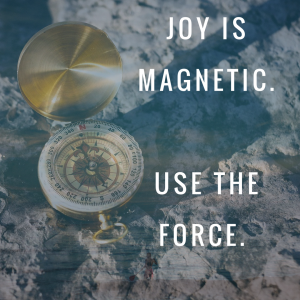Every time you express a complaint about how difficult and tiresome it is to be creative, inspiration takes another step away from you, offended. Elizabeth Gilbert
In her book, Big Magic: Creative Living Beyond Fear, Gilbert takes a practical common sense attitude towards living a joy-filled, creative life I can appreciate. It’s a breath of fresh air that makes creativity feel accessible to anyone and dispels the myth of the suffering artist.
The risk we take
 Actually, when we focus more on the negatives in any area of our lives, we risk becoming boring and a repelling force. Chasing people away with our attitude runs counter to success in any endeavour, creative or otherwise.
Actually, when we focus more on the negatives in any area of our lives, we risk becoming boring and a repelling force. Chasing people away with our attitude runs counter to success in any endeavour, creative or otherwise.
That’s why I’m heeding Elizabeth Gilbert’s advice to focus on the joy of my creative practice. That doesn’t mean the work isn’t difficult times and I don’t get tired. Hardly.
What is joy?
I’m not blind to the hard work (and yes, sometimes sacrifice) it takes to create from the heart. And I’m no Pollyanna. I grew up in a dysfunctional home with a mentally ill mother, so I get it. Life can be tough and painful and even frightening at times but I don’t need to drag that along behind me.
Yes, we experience joy in the bright moments but it’s also there in the shadows. A friend of mine put her busy life on hold to care for her mother in the final stages of a terminal illness. After her mother was gone, she shared with me that their time together had joy laced liberally into the sadness.
Joy isn’t about being giddy but rather feeling deeply fulfilled by an experience.
Find your own joy
We’ve been well-taught to look for the negative. The marketing messages you’ve heard most of your life start with the idea you’re not good enough and need to be fixed. (We can help! Buy our product!) So shifting your perspective may take some re-training of your inner chatter.
Here are some tips that can help.
First, pay attention
That inner chatter is powerful. Train yourself to be aware of the negative words you repeat to yourself, especially about your art. Write them down, if you need to. Whenever you hear one pop up, challenge it by responding “Says who?”
Change the conversation.
Second, stop comparing yourself
The habit of comparison always gets in the way of our satisfaction and joy. If we look at the public works of a successful artist and think “I could never do that”, we overlook the ‘learning curve’ pieces, hidden away in closets or thrown in the trash.
Third, actively look for what works
Back when I facilitated creative writing workshops, I followed the AWA method. My training in the methodology emphasized providing feedback only on the strong writing.
“What works? What moves me? What emotions do I experience?”
I witnessed the magic of that again and again. The weak writing fell away simply because we humans crave the positive feedback. “You liked that? I’ll do more of it!”
Each week the writing improved. Many of my students went on to be published, so we were definitely doing something right. I only ever had one participant who constantly complained that unless I told her what was wrong, she couldn’t fix it.
Missing the point, she also missed the joy her art could have brought to herself and others.
Choose
In the end, joy is a choice. I choose joy.

